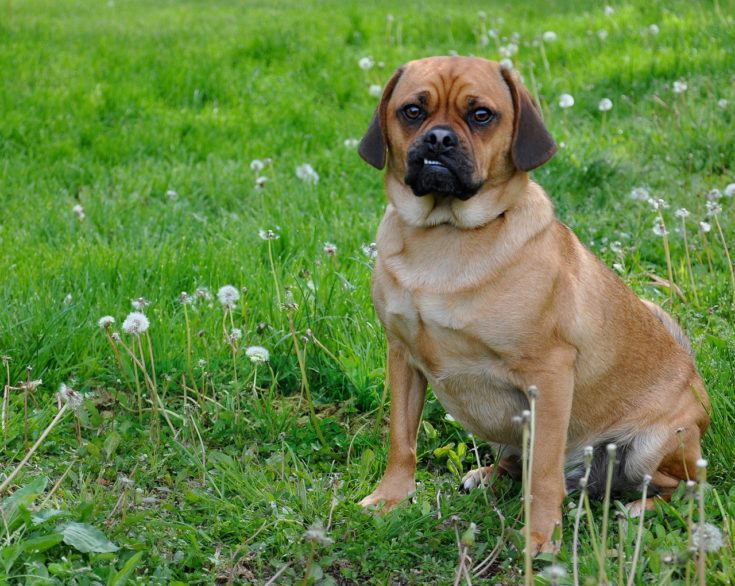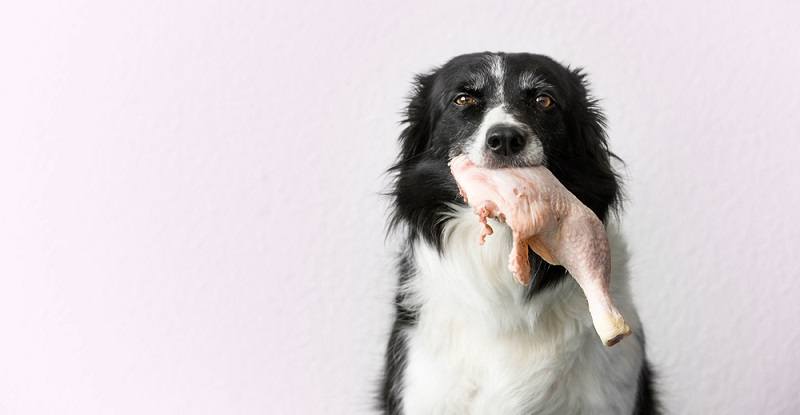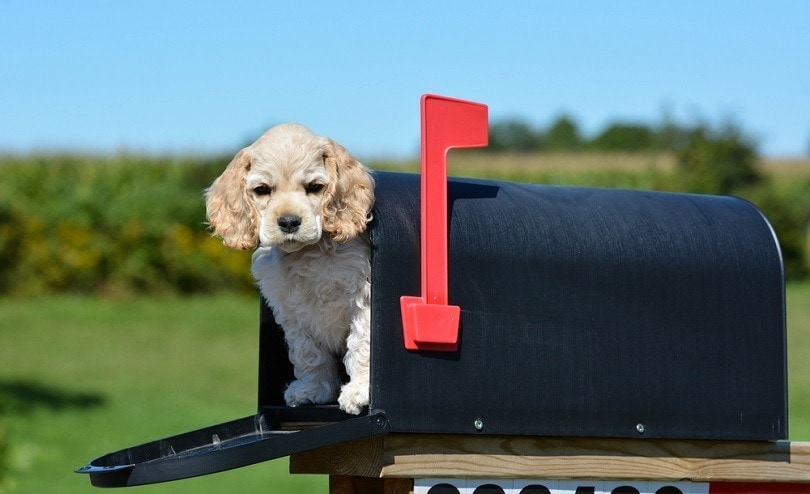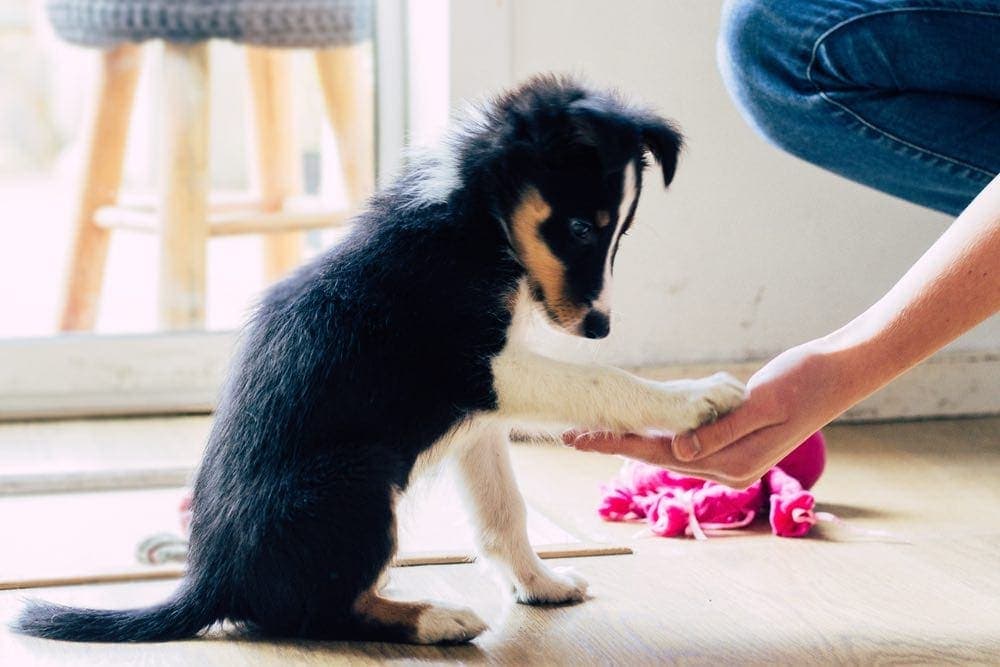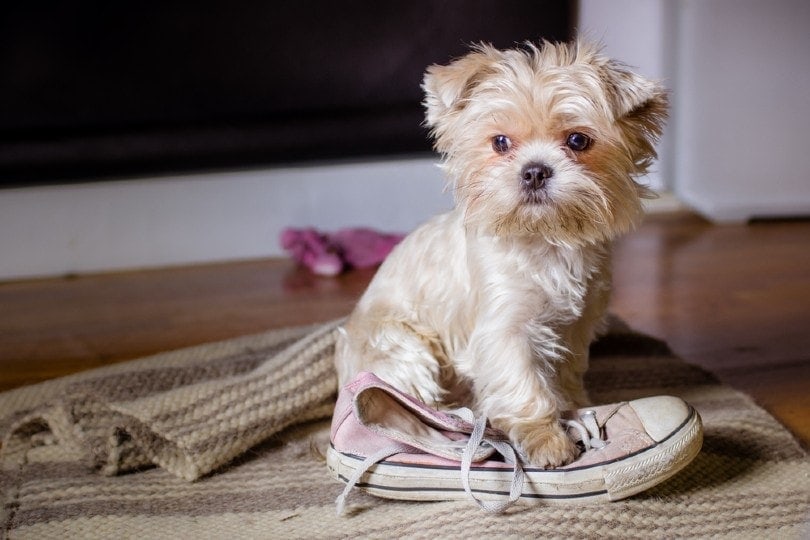Height:
10-16 inches
Weight:
14-30 pounds
Lifespan:
12-15 years
Colors:
Any hound color, silver, apricot, fawn, black, often with a black mask and ears
Suitable for:
Families with children, those looking for a people-loving dog, country or city living
Temperament:
Outgoing, Loving, Affectionate, Curious, Intelligent, Eager to please, Gets along well with children, Stubborn
The Puggle was originally an accidental mixing of the Pug and Beagle. But once breeders met these charming pups and saw how healthy they were, the Puggle quickly became a popular designer dog hybrid.
And we can see why! Puggles are some of the kindest and most loving companion dogs around. These upbeat, pint-sized adventurers are bright, curious, and love spending quality time with their family.
These dogs are a becoming mix of the best traits of the Beagle and Pug. To get a better idea of the history of the Puggle, here’s a little background on the parent breeds.
The Beagle breed as we know it today originates in England over 150 years ago. They were developed as hunters and hounds but have become most popular in recent years as companion dogs. Beagles have been one of the most popular breeds in North America for over 25 years.
The Pug, on the other hand, is an ancient breed. The progenitors of the Pug likely originated in China over 2,000 years ago! They began as the pets of royalty, slowly made their way to Tibet and Japan, and showed up in Europe around the 16th or 17th century.
Puggle Puppies – Before You Buy…
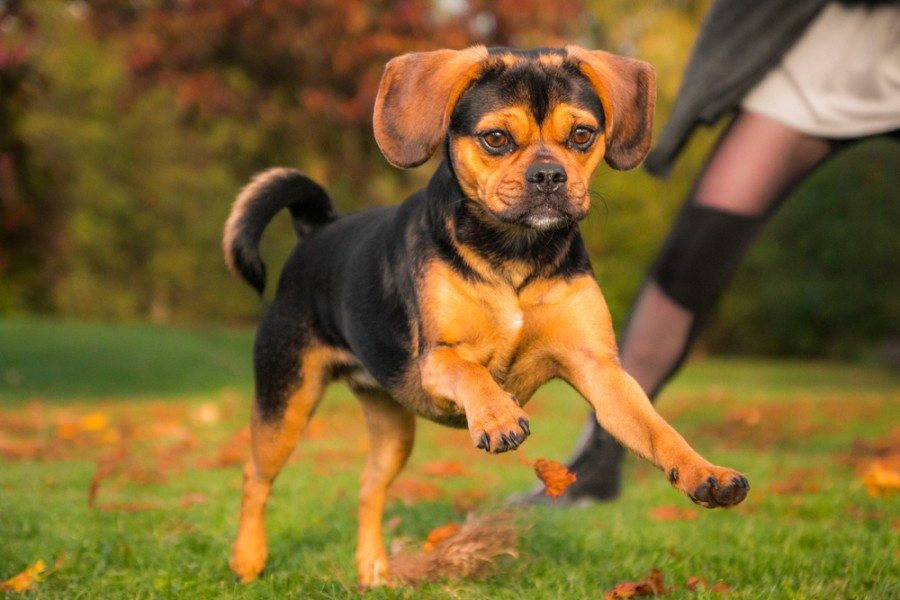
Though Puggles have a frowning, serious expression, nothing could be farther from the truth! These pups are exceptionally playful and affectionate. Puggles make wonderful family dogs and companions, and they love being around people.
That funny, grumpy face alone has been many a prospective dog owner’s undoing. Before going to a breeder or shelter it would be wise to seriously consider if you have the finances, time, and energy to dedicate to a dog for the next 15 years. Because once you meet them, trust us, you’re a goner!
If you are getting your Puggle from a breeder don’t be embarrassed to ask for advice and recommendations. A knowledgeable breeder will be able to tell you all about food choices, toys and games, socialization techniques, and even health care.
What’s the Price of Puggle Puppies?
Even if the first of the Puggle breed may have been an accident, many people have been won over by these cheerful fellows! Combined with the relative popularity of the parent breeds, finding a Puggle shouldn’t be terribly challenging or expensive.
For a Puggle from a breeder, you are likely to see prices anywhere from $500 to $2,000. This variation depends mainly on bloodlines and pedigrees. If you are not looking to start your own breeding program or go to dog shows you can often find them for closer to the low-end price.
Since the Puggle has been gaining popularity it is also more possible to find them in shelters and up for adoption. For those willing to be patient, adopting a Puggle usually costs a maximum of $350 and includes relevant shots and are neutered/spayed.
3 Little-Known Facts About the Puggle
1. Beagles Used to Be Tiny Too
When the Beagle breed was in the beginnings of being established, there was a larger differentiation in size than there is now. According to the 18th-century poet, Gervase Markham, some Beagles were bred to be so tiny that they could sit in the palm of your hand, or be tucked inside a ladies kirtle!
Though they were small for a hound, they are no less capable than their bigger cousins. The same poet wrote of the Beagle that they “run as cunningly as any hound whatere, only their musick is very small like reeds.” Beagles are a bit bigger now, but just as quick, alert, and sweet!
2. Pugs Are Tiny Mastiffs
It is a commonly accepted theory that Pugs were initially bred as miniature mastiffs. All the genial personality and goodwill towards family, and none of the slobber or crushed furniture!
In ancient times Pugs were kept by Chinese royalty, but as the breed spread in popularity, they found a home with the Buddhist monks in temples all across Tibet. Though they started out as a longer, leaner breed they have slowly been guided to their current pudgy and adorable shape.
3. Puggles Are a Healthier Mix Than Either Parent Breed
The Puggle is a resounding example of a mixed breed that is healthier than either of the parents!
The longer snout of the Beagle effectively cuts out any of the common brachycephalic issues that Pugs are prone to. A Puggle’s eyes are also significantly healthier than most Pugs, and they are no longer likely to pop out (yikes!) or suffer from congenital eyelid abnormalities.
On the flip side, the Pug also brings amazing befits to this mixed breed. Pugs are some of the friendliest, most easy-going dogs around and this predominate personality trait smooths out the often nervous and anxious Beagle.

Temperament & Intelligence of the Puggle
These are some of the happiest and friendliest little dogs around! Puggles are a charming mix of good-natured, independent, loving, and inquisitive. They are total people-pleasers and love playing with children and other animals.
Puggles will flourish in an environment where they can be close to people and do best with couples or families with children. They love to follow family members around and get their noses into everything that you do! Busy body, or best friend? That’s for you to decide.
And though their muzzles are much less squished down than the Pug, don’t be surprised if your Puggle is a snorer. Puggles are famous for their expressive vocalizations and may howl, snort, and otherwise “talk” in ways that defy simple barking.
Are These Dogs Good for Families?
Few smaller dog breeds are as loving, patient, and cuddly as the Puggle. Though we all have our different personalities, we’ve never met a Puggle that didn’t enjoy spending time with children.
Socializing your Puggle and children with each other early on is sensible, though these pups are naturally friendly. And don’t shirk teaching your kids how to respect a dog, as the small stature of Puggles can make them easier targets for bullying.
Does This Breed Get Along with Other Pets?
The Puggle’s extroversion with people also translates to other dogs and animals. Puggles are genial and kind dogs with other animals, making them a great choice for a multi-pet home. And with some socializing, it’ll be smooth sailing!
The only thing to keep in mind when letting your pets interact is that Puggles may inherit a little hunting instinct from their Beagle parent. It may be wise to supervise a Puggle’s initial interactions with cats and avoid interaction with small pets and prey animals altogether.
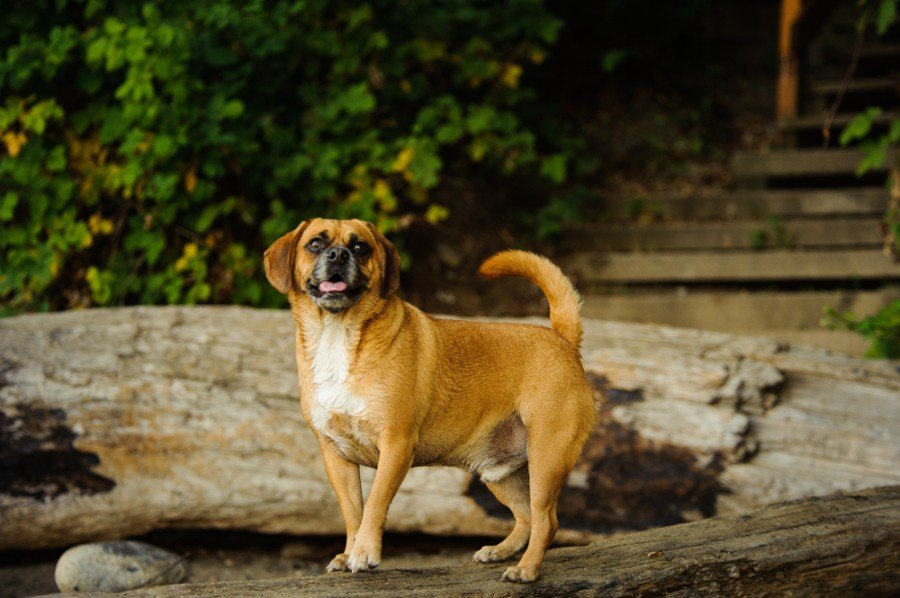
Things to Know When Owning a Puggle
Still mulling over whether the Puggle is for you? Here’s a basic rundown of day-to-day care and upkeep for one of these little scamps!
Food & Diet Requirements
Commercial dog foods can be an excellent way to make sure your Puggle is getting a well-balanced diet. Look for food designed for smaller breeds and avoid questionable by-product ingredients and excessive grains. Whole foods are great for dogs – animal proteins, healthy fats, and fruits and veggies too!
Puggles are naturally a little chubby, and you should keep an eye on their weight to make sure it doesn’t veer into unhealthy territory. Lean proteins like fish and fowl will serve these little adventurers well, giving them plenty of energy to burn without weighing them down.
Exercise
Apartment dwellers and city folk rejoice, this compact pup is a great companion for nearly any living situation! We recommend giving your Puggle at least one long walk a day, as well as providing indoor activities. They don’t need a lot of exercise, but they love playing with the family.
Puggles deeply enjoy a good outdoor adventure where they can smell absolutely everything. But they are also conveniently sized, of moderate energy levels, and social enough that city living with sufficient exercise will suit them fine.
These fine fellows can be very sensitive to heat, however, so avoid taking your Puggle out during the hottest parts of the day. And if they spend much time outdoors make sure they have a shady, cool area to relax.

Training
The Puggle is a charming mixture of eager to please and stubborn. They love entertaining you and receiving endless affection, but also don’t like being bossed around. A gentle and treat generous hand is needed to train these pups, as well as plenty of patience.
When you’re learning to communicate with and provide guidance for your Puggle, we recommend positive reinforcement training above all. Don’t give them repetitive tasks, as they may grow bored and distracted. And do give them lots of praise and snacks when they follow directions.
The most important command you can instill in a Puggle is recall, or “come.” These inquisitive chaps inherit the love of pursuing a scent from the Beagle and can become distracted when off-leash.
Grooming ✂️
Puggles are moderate shedders and will benefit from having their coats brushed a few times a week. With a low-key routine, their short hair is simple to maintain.
All pups need to have their ears, teeth, and nails checked to keep them healthy. Ears should be swabbed of excess dirt and wax, and teeth ought to be brushed on a weekly basis. Clip your little friend’s toenails on occasion as well so that they don’t curl, crack, or get caught in rugs and clothing.
Health and Conditions
The Puggle is a perfect example of how mixing purebred dogs can result in a significantly healthier pup.
For example, the muzzle shape of the Beagle gives a Puggle’s sinuses more room and avoids the many breathing-related issues of the Pug. And the relaxed temperament of the Pug mellows the sometimes-anxious Beagle.
Though very healthy and unlikely to be prone to serious conditions, it is possible for a Puggle to inherit any of the common ailments of their parent breeds. To be as thorough as possible, here is a list of the health concerns that could be pertinent for a Puggle.
- Sensitivity to heat
- Deformities of the eye, nose, mouth
- Legg-Perthes disease
- Luxating patellas
- Cleft palate
- Demodectic mange
- Dwarfism
- Hypothyroidism
- Intervertebral disc disease
- Pug dog encephalitis
- Epilepsy
- Intervertebral disc disease
- Musladin Lueke syndrome (MLS)
- Hip and elbow dysplasia
Male vs Female
The male Puggle is a little larger and more likely to mark territory with urine or display sexually aggressive behaviors (e.g., mounting or humping).
And female Puggles are a bit more delicate and less chunky. They are often quieter, and more relaxed than their male counterparts.
Final Thoughts
So, is the Puggle the right dog for you?
If you’re a dog lover that is looking for a city-friendly breed, the Puggle should be at the top of your list.
And if you are seeking an affectionate companion for you or your children, the Puggle simply cannot be beat! An absolute charmer, the Puggle will win your heart immediately – and keep it!
Featured Image: Needpix

